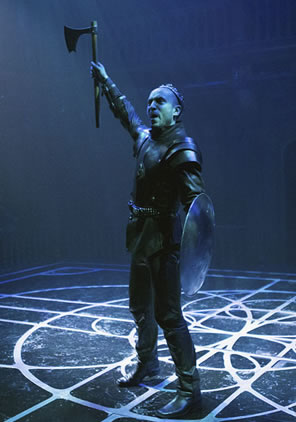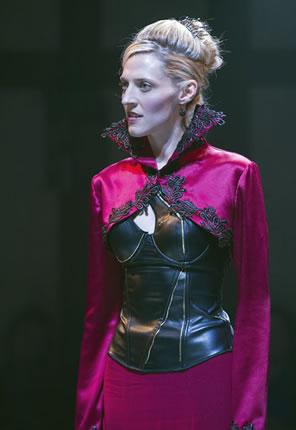Richard III
Looking for Bodies to Bury
Folger Theatre, Washington, D.C.
Saturday, February 1, 2014, E–101&102 (left side main riser of theater in the round)
Directed by Robert Richmond
Two plays, alike in title: William Shakespeare's Richard III. Both opened on the same night within 25 miles of each other, one at the venerable Folger Theater on Capitol Hill in downtown Washington, D.C., the other by the fledgling NextStop Theatre Company in suburban Herndon, Va. The Folger version, the first production ever to be presented in the round there, follows a more traditional course in featuring a "halting" Richard with a limp, though director Robert Richmond takes a few liberties with his management of the other characters. The NextStop version, in a studio theater, turns the title character into a Deaf man, and director Lindsey D. Snyder takes liberties with her management of the other characters to accommodate Richard's hearing impairment. In this tale of two Richards, we look at two approaches to the play: one inside out, the other outside in. One production mines Shakespeare's text for allegorical relevance and achieves resonant theater as a result; the other has its thematic arc imposed upon it and relies on gimmickry for its dramatic value. Which is which might surprise you. For the review of NextStop Theatre's Deaf Richard, click here.

Drew Cortese as Richard preparing for the Battle of Bosworth in The Folger production of Richard III. Photo by Teresa Wood, Folger Library.
The discovery of the real Richard III's skeletal remains in a makeshift grave under a parking lot in Leicester, England, a little over a year ago has prompted the inclusion of William Shakespeare's Richard III in theater calendars around the world ever since. Director Robert Richmond, however, is infatuated with the grave itself, maybe more so than with the character of the man whose skeleton was unearthed, and he carries that infatuation to extremes in his production of the play at The Folger—so extreme, he had the library tear apart its theater and reconfigure it with the playing space platform in the center of the room. Tony Cisek's set design is a black rectangle with silver metal geometric designs marking out a total of nine trapdoors that serve as graves.
"Thinking of the skeletal remains under the parking lot, we focus on inappropriate burial and the dark, sinister forces of the afterlife," Richmond writes in his program notes. In a Washington Post interview he is quoted as saying, "Graves became very important to the story. People are disappearing and are clearly being buried without ceremony. There are no funerals." Well, across the canon, Shakespeare doesn't bother much with funerals unless they have some dramatic purpose, as Ophelia's in Hamlet and Henry V's at the beginning of Henry VI, Part One. Oh, and Henry VI's in this play. True, Richard has the body moved to a different location—Shakespeare following the chronicles—but Richmond dispenses with this little tidbit in the script so that he can stick to his own unceremonious burials motif.
Although Shakespeare has all the murders committed off stage, Richmond murders all the victims on stage so that they can descend into a grave. We enter the theater to a soundtrack of funereal organ music and see Henry VI's shrouded corpse on a bier; we end the play witnessing one final grave (for a spoiler edition of this review, click here). And with every "burial," we hear the afterlife, which is a very noisy place (no resting in peace for any of these victims). In Richard's Bosworth-eve dream, the ghosts come forth from their tombs like specters in Disney's Haunted Mansion, and they also appear in the battle.
So that we can see all this burying, Richmond convinced The Folger to reconfigure its Elizabethan court theater into a theater-in-the-round. "We have created an immersive theatrical experience that puts you, the audience member, 'up close and personal' with Richard's thoughts and decisions," Richmond writes. "By moving the action to the center, you, the audience, now occupy the same space, share the same oxygen, and are complicit to the decisions of a serial killer." Frankly, we have always occupied the same space and shared the same oxygen in that already intimate theater. Rather, retrofitting a space never meant for such a configuration always ends up being problematic. Some in the audience had difficult sightlines, there was a weird sense of scale, and while half the audience were tight around three edges, the rest of us occupied a grandstand on The Folger's original stage breathing less of the actors' oxygen than we might have been in the normal configuration. Breaking down the fourth wall should not mean re-creating it in a different form.
Furthermore, our complicity depends on the actor, not the space. Drew Cortese's Richard never lets us get "up close" to his thoughts or get "personal" with his decisions. We get no sense of what makes him a psychopath; in fact, we barely get a sense of his presence in the space, let alone any outsized personality. Cortese limps, but he has no other deformity, not even the scoliosis evident in the real Richard's skeleton, and his withered hand looks like a cramp he happens to have suddenly incurred before having Hastings killed. This Richard has an easy-going cynicism in his manner, but that is put to greater display in his public interactions with other characters than in his soliloquies with the audience, and the laughs peter out early in this production. His final tell-all soliloquy after his dreams is excised, and we are left with a Richard who is little more than a dangerous jerk. Cortese obviously has the acting chops to do more, so I fault choices by a director who has demonstrated in previous productions how much he loves to fiddle with Shakespeare's purposes and this time ends up playing a completely different tune than the one Shakespeare arranged.
For example, not only does Richard successfully woo Lady Anne (Alyssa Wilmoth Keegan), they become the picture of a perfectly happy couple at court. They hold hands when they are side by side, and she looks admiringly on him when they are not. This has the effect of neutralizing Richard while making Anne not so much an innocent victim but another complicit politician earning an unjust dessert. She does get a little worried when she overhears Margaret warning Buckingham of "yonder dog"—but hasn't Anne heard Richard badmouthed before? Like, maybe, from her own mouth? Anne is the woman who, in the preceding scene, calls Richard "hated wretch," "fiend," "dreadful minister of hell," "foul devil," "villain," "diffus'd infection of a man," "devilish slave," "hedgehog," "foul toad," and "dissembler" and spit on him. How crazy Margaret's curses could be the thing that gets Anne to second-guess her husband isn't clear.
Yet, Keegan's Anne is, in her Shakespearean moments, superbly portrayed, lamenting her dead father-in-law with the sorrow of a young woman not only left widowed but bereft of royal protection, and she is powerfully vehement in her initial reproach of Richard when he comes a-wooing. What turns her is his recounting of how he cried upon hearing of his own dad's death, and in this report she seems to realize that the victims in England's civil wars wear roses of both colors. Also, that ring Richard gives her catches her fancy, and it represents a renewed royal protection. However, long before he says so, Richard is already desiring the young Princess Elizabeth, added to the play in the person of Jenna Berk in a silent role, whom Cortese's Richard is constantly pawing when she's on stage.
"Crazy Margaret" describes both the verbal and physical demeanor of Naomi Jacobson's portrayal of Henry VI's widowed queen; she has a black tattoo on her face, looking like she may be a fourth weird sister in a character exchange program from Macbeth. Shakespeare seems to have brought her unhistorically into the sequel of his Henry VI plays because she had become a popular character for London playgoers (evidence is in the way he builds up her first entrance in Part Three). Some productions cut Margaret as inconsequential to the story of Richard, others make much of her penchant for making accurate curses, having her show up every time one comes true. In this production, Margaret, though long gone to France, suddenly shows up at the end to stomp on the grave that just swallowed Richard and shout, "The bloody dog is dead!" That's really the Earl of Richmond's line, but as she had prayed that she "may live and say 'The dog is dead'," Richmond the director trumps Richmond the character by granting her wish and letting her say it in his production. That's nice of him to do so for her sake, but Richard III becomes, effectively, Margaret, Part Four.

Julia Motyka's Elizabeth. Photo by Teresa Wood, Folger Library.
Perhaps Margaret is meant to represent the "dark, sinister forces of the afterlife" along with the fiendish soundtrack of each burial. So, perhaps, is costume designer Mariah Hale's hybrid modern and 19th century Gothic wardrobe. The men are in long coats and leather pants, the guards wear SWAT cops uniforms, and the women dress in floor-length Victorian dresses. I thought I had stumbled into a vampire's lair, especially with Julia Motyka as Queen Elizabeth in a long, sleek, red satiny gown with black laced high collar and overlong cuffs on her jacket and a single-strap black leather corset underneath.
Motyka's Elizabeth is haughty, self-absorbed, and most aware. When Richard is wooing her to marry her daughter, Motyka takes off the jacket, throws it aside, and begins circling Richard as if preparing to fistfight the king. She even shoves him hard in the chest a couple of times until he finally cocks his fist, ready to slug her; and she stands ready to take the blow, knowing he wouldn't dare. At the end of this intensely titillating scene, Motyka's Elizabeth plants a deep kiss on Richard, who recoils in horror. Who is the monster here?
Howard W. Overshown also gives a commanding performance as Buckingham; in this production, he's clearly the more conspicuously sinister in his pairing with Richard and would definitely have made the more effective king. Michael Sharon is a well-read Catesby who delights in his boss's shenanigans with a kind of nerdish fervor. Sharon does double duty as Clarence, putting us right inside his dream as he describes it.
Another highlight in a production that cuts many notable scenes and lines comes courtesy of Director Richmond's absolutely right choice to keep in Stanley's petitioning for the pardon of a servant convicted of murder, a solicitation Stanley makes immediately upon King Edward hearing of the death of his brother Clarence. Paul Morella roars out Edward's speech of lament that no one sued to him for Clarence's life. "Who spoke of brotherhood? Who spoke of love?" So soul-rattling is Morella's delivery of this speech that not only do the characters on stage—including Cortese's Richard—look chagrined, but the audience also feels complicit. This is the kind of connection to the emotions in Shakespeare's script that Director Richmond claims he was striving for with his burials and theater reconstruction. Had the rest of the play been as arresting as this scene, he could have turned The Folger upside down and buried us with Richard, and we'd still feel richly rewarded.
Eric Minton
February 4, 2014
Comment: e-mail editorial@shakespeareances.com
Start a discussion in the Bardroom



 Find additional Shakespeareances
Find additional Shakespeareances